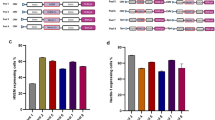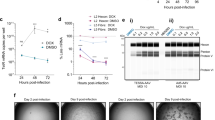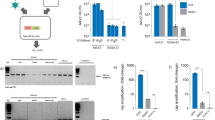Abstract
Recombinant adeno-associated virus type 2 (rAAV) vectors have recently been used to achieve long-term, high level transduction in vivo. Further development of rAAV vectors for clinical use requires significant technological improvements in large-scale vector production. In order to facilitate the production of rAAV vectors, a recombinant herpes simplex virus type I vector (rHSV-1) which does not produce ICP27, has been engineered to express the AAV-2 rep and cap genes. The optimal dose of this vector, d27.1-rc, for AAV production has been determined and results in a yield of 380 expression units (EU) of AAV-GFP produced from 293 cells following transfection with AAV-GFP plasmid DNA. In addition, d27.1-rc was also efficient at producing rAAV from cell lines that have an integrated AAV-GFP provirus. Up to 480 EU/cell of AAV-GFP could be produced from the cell line GFP-92, a proviral, 293 derived cell line. Effective amplification of rAAV vectors introduced into 293 cells by infection was also demonstrated. Passage of rAAV with d27.1-rc results in up to 200-fold amplification of AAV-GFP with each passage after coinfection of the vectors. Efficient, large-scale production (>109 cells) of AAV-GFP from a proviral cell line was also achieved and these stocks were free of replication-competent AAV. The described rHSV-1 vector provides a novel, simple and flexible way to introduce the AAV-2 rep and cap genes and helper virus functions required to produce high-titer rAAV preparations from any rAAV proviral construct. The efficiency and potential for scalable delivery of d27.1-rc to producer cell cultures should facilitate the production of sufficient quantities of rAAV vectors for clinical application.
This is a preview of subscription content, access via your institution
Access options
Subscribe to this journal
Receive 12 print issues and online access
$259.00 per year
only $21.58 per issue
Buy this article
- Purchase on Springer Link
- Instant access to full article PDF
Prices may be subject to local taxes which are calculated during checkout






Similar content being viewed by others
References
Kessler PD et al. Gene delivery to skeletal muscle results in sustained expression and systemic delivery of a therapeutic protein Proc Natl Acad Sci USA 1996 93: 14082–14087
Herzog RW et al. Stable gene transfer and expression of human blood coagulation factor IX after intramuscular injection of recombinant adeno-associated virus Proc Natl Acad Sci USA 1997 94: 5804–5809
Koeberl DD et al. Persistent expression of human clotting factor IX from mouse liver after intravenous injection of adeno-associated virus vectors Proc Natl Acad Sci USA 1997 94: 1426–1431
Nakai H et al. Adeno-associated viral vector-mediated gene transfer of human blood coagulation factor IX into mouse liver Blood 1998 91: 4600–4607
Monahan PE et al. Direct intramuscular injection with recombinant AAV vectors results in sustained expression in a dog model of hemophilia Gene Therapy 1998 5: 40–49
Song S et al. Sustained secretion of human alpha-1-antitrypsin from murine muscle transduced with adeno-associated virus vectors Proc Natl Acad Sci USA 1998 95: 14384–14388
Kaplitt MG et al. Long-term gene expression and phenotypic correction using adeno-associated virus vectors in the mammalian brain Nat Genet 1994 8: 148–154
Peel AL et al. Efficient transduction of green fluorescent protein in spinal cord neurons using adeno-associated virus vectors containing cell type-specific promoters Gene Therapy 1997 4: 16–24
Xiao X et al. Adeno-associated virus (AAV) vector antisense gene transfer in vivo decreases GABA(A) alpha1 containing receptors and increases inferior collicular seizure sensitivity Brain Res 1997 756: 76–83
Flotte TR, Carter BJ . Adeno-associated virus vectors for gene therapy of cystic fibrosis Meth Enzymol 1998 292: 717–732
Muzyczka N . Use of adeno-associated virus as a general transduction vector for mammalian cells Curr Top Microbiol Immunol 1992 158: 97–129
Samulski RJ et al. Rescue of adeno-associated virus from recombinant plasmids: gene correction within the terminal repeats of AAV Cell 1983 33: 135–143
Hermonat PL, Muzyczka N . Use of adeno-associated virus as a mammalian DNA cloning vector: transduction of neomycin resistance into mammalian tissue culture cells Proc Natl Acad Sci USA 1984 81: 6466–6470
Berns KI . The Parvoviruses Plenum Press: New York 1984
Chejanovsky N, Carter BJ . Mutagenesis of an AUG codon in the adeno-associated virus rep gene: effects on viral DNA replication Virology 1989 173: 120–128
Samulski RJ, Chang LS, Shenk T . A recombinant plasmid from which an infectious adeno-associated virus genome can be excised in vitro and its use to study viral replication J Virol 1987 61: 3096–3101
Carter BJ . The growth of adeno-associated virus In: Tijssen P (ed) . Handbook of Parvoviruses CRC Press: Boca Raton 1990 pp 155–168
Huang MM, Hearing P . Adenovirus early region 4 encodes two gene products with redundant effects in lytic infection J Virol 1989 63: 2605–2615
Samulski RJ, Shenk T . Adenovirus E1B 55-Mr polypeptide facilitates timely cytoplasmic accumulation of adeno-associated virus mRNAs J Virol 1988 62: 206–210
Xiao X, Li J, Samulski RJ . Production of high-titer recombinant adeno-associated virus vectors in the absence of helper adenovirus J Virol 1998 72: 2224–2232
Matsushita T et al. Adeno-associated virus vectors can be efficienty produced without helper virus Gene Therapy 1998 5: 938–945
Clark KR et al. Cell lines for the production of recombinant adeno-associated virus Hum Gene Ther 1995 6: 1329–1341
Vincent AJ et al. Preclinical testing of recombinant adenoviral herpes simplex virus-thymidine kinase gene therapy for central nervous system malignancies Neurosurgery 1997 41: 442–451
Li J, Samulski RJ, Xiao X . Role for highly regulated rep gene expression in adeno-associated virus vector production J Virol 1997 71: 5236–5243
Rose JA, Koczot F . Adenoviurs-associated virus multiplication VII. Helper requirement for viral deoxyribonucleic acid and ribonucleic acid systhesis J Virol 1972 10: 1–8
Buller RML . Herpes simplex virus types 1 and 2 completely help adnovirus-associated virus replication J Virol 1981 40: 241–247
Mishra L, Rose JA . Adeno-associated virus DNA replication is induced by genes that are essential for HSV-1 DNA synthesis Virology 1990 179: 632–639
Weindler FW, Heilbronn R . A subset of herpes simplex virus replication genes provides helper functions for productive adeno-associated virus replication J Virol 1991 65: 2476–2483
Knipe DM . The role of viral and cellular nuclear proteins in herpes simplex virus replication (review) Adv Virus Res 1989 37: 85–123
Weller SK . Genetic analysis of HSV-1 gene required for genome replication In: Wagner EK (ed) . Herpes Virus Transcription and its Regulation CRC Press: Boca Raton 1991 pp 105–136
Rice SA, Knipe DM . Genetic evidence for two distinct transactivation functions of the herpes simplex virus alpha protein ICP27 J Virol 1990 64: 1704–1715
Conway JE et al. Recombinant adeno-associated virus replication and packaging is supported by an HSV amplicon expressing Rep and Cap J Virol 1997 71: 8780–8789
Carter BJ et al. Properties of an adenovirus type 2 mutant, Ad2dl807, having a deletion near the right-hand genome terminus: failure to help AAV replication Virology 1983 126: 505–516
Green MR, Roeder RG . Transcripts of the adeno-associated virus genome: mapping of the major RNAs J Virol 1980 36: 79–92
Laughlin CA et al. Defective-interfering particles of the human parvovirus adeno-associated virus Virology 1979 94: 162–174
Lusby E, Fife KH, Berns KI . Nucleotide sequence of the inverted terminal repetition in adeno-associated virus DNA J Virol 1980 34: 402–409
Marcus CJ, Laughlin CA, Carter BJ . Adeno-associated virus RNA transcription in vivo Eur J Biochem 1981 121: 147–154
Khleif SN et al. Inhibition of cellular transformation by the adeno-associated virus rep gene Virology 1991 181: 738–741
Heilbronn R et al. The adeno-associated virus rep gene suppresses herpes simplex virus-induced DNA amplification J Virol 1990 64: 3012–3018
Weitzman MD et al. Interaction of wild-type and mutant adeno-associated virus (AAV) Rep proteins on AAV hairpin DNA J Virol 1996 70: 2440–2448
Weitzman MD, Fisher KJ, Wilson JM . Recruitment of wild-type and recombinant adeno-associated virus into adenovirus replication centers J Virol 1996 70: 1845–1854
Quinlan MP, Chen LB, Knipe DM . The intranuclear location of a herpes simplex virus DNA binding protein is determined by the status of viral DNA replication Cell 1984 36: 857–868
Liptak LM, Uprichard SL, Knipe DM . Functional order of assembly of herpes simplex virus DNA replication proteins into prereplicative site structures J Virol 1996 70: 1759–1767
Lukonis CJ, Weller SK . Characterization of nuclear structures in cells infected with herpes simplex virus type 1 in the absence of viral DNA replication J Virol 1996 70: 1751–1758
Zhong L, Hayward GS . Assembly of complete functionally active herpes simplex virus DNA replication compartements and recruitement of associated viral and cellular proteins in transient cotransfection assays J Virol 1997 71: 3146–3160
Zolotukhin S et al. A ‘humanized’ green fluorescent protein cDNA adapted for high-level expression in mammalian cells J Virol 1996 70: 4646–4654
Sandri-Goldin RM, Mendoza GE . A herpesvirus regulatory protein appears to act post-transcriptionally by affecting mRNA processing Genes Dev 1992 6: 848–863
McLauchlan J et al. Herpes simplex virus IE63 acts at the posttranscriptional level to stimulate viral mRNA 3′ processing J Virol 1992 66: 6939–6945
Johnson LG et al. Efficiency of gene transfer for restoration of normal airway epithelial function in cystic fibrosis Nat Genet 1992 2: 21–25
Johnson NW, Curtis MA . Preventive therapy for periodontal diseases (review) Adv Dental Res 1994 8: 337–348
Weindler FW, Heilbronn R . A subset of herpes simplex virus replication genes provides helper functions for productive adeno-associated virus replication J Virol 1991 65: 2476–2483
Clark KR, Voulgaropoulou F, Johnson PR . A stable cell line carrying adenovirus-inducible rep and cap genes allows for infectivity titration of adeno-associated virus vectors Gene Therapy 1996 3: 1124–1132
Acknowledgements
This work was supported in part by grants from the National Institutes of Health to BJB, POI, HL59412 and NCI T32-CA-09243 to JEC. We gratefully acknowledge the gifts of d27.1, the V27 cell line and P Ab 3–83 from D Knipe, and the C12 cell line from PR Johnson. We also appreciate the assistance of Jennifer Hussey in infectious center assays and the suggestions of Kye Chesnut in the preparation of this manuscript.
Author information
Authors and Affiliations
Rights and permissions
About this article
Cite this article
Conway, J., Rhys, C., Zolotukhin, I. et al. High-titer recombinant adeno-associated virus production utilizing a recombinant herpes simplex virus type I vector expressing AAV-2 Rep and Cap. Gene Ther 6, 986–993 (1999). https://doi.org/10.1038/sj.gt.3300937
Received:
Accepted:
Published:
Issue Date:
DOI: https://doi.org/10.1038/sj.gt.3300937
Keywords
This article is cited by
-
Molecular design for recombinant adeno-associated virus (rAAV) vector production
Applied Microbiology and Biotechnology (2018)
-
Production of Recombinant Adeno-associated Virus Vectors Using Suspension HEK293 Cells and Continuous Harvest of Vector From the Culture Media for GMP FIX and FLT1 Clinical Vector
Molecular Therapy (2016)
-
Manufacturing of recombinant adeno-associated viral vectors for clinical trials
Molecular Therapy - Methods & Clinical Development (2016)
-
A scalable method for the production of high-titer and high-quality adeno-associated type 9 vectors using the HSV platform
Molecular Therapy - Methods & Clinical Development (2016)
-
Enhancing gene delivery of adeno-associated viruses by cell-permeable peptides
Molecular Therapy - Methods & Clinical Development (2014)



